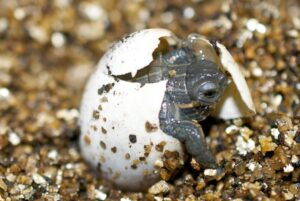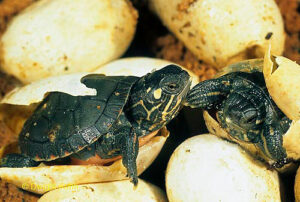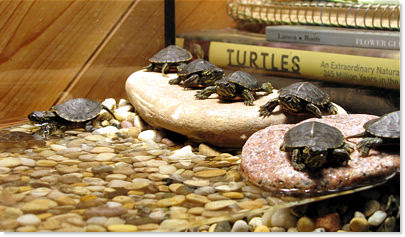Curious about the enchanting world of painted turtle eggs? Well, get ready to embark on an exciting journey as we unravel the mystery behind one burning question: “How long do painted turtle eggs take to hatch?”
Painted turtle eggs typically take around 60 to 90 days to hatch. However, this timeframe can vary depending on factors such as temperature and humidity levels during incubation. Warmer temperatures tend to speed up the hatching process, while cooler temperatures may prolong it.
During this period, the eggs undergo a remarkable transformation, culminating in the emergence of adorable painted turtle hatchlings ready to begin their journey in the wild.
Importance of understanding the incubation period for painted turtle eggs

Understanding the incubation period for painted turtle eggs is crucial for several reasons:
- Reproductive Success: Knowing the duration of the incubation period helps ensure the reproductive success of painted turtles. Painted turtles, like many reptiles, rely on environmental factors such as temperature to regulate the development of their eggs. Understanding the optimal conditions for incubation ensures a higher likelihood of successful hatching.
- Conservation Efforts: For conservationists working to protect painted turtle populations, understanding the incubation period is vital. It allows them to create and manage protected nesting sites with optimal conditions, such as proper temperature and moisture levels, to maximize egg viability and hatchling survival rates.
- Population Monitoring: Monitoring the duration of the incubation period can provide valuable insights into the health and reproductive habits of painted turtle populations. Changes in the length of the incubation period over time could indicate shifts in environmental conditions or population dynamics, helping researchers assess the overall health of the species.
- Life Cycle Studies: Understanding the timing of the incubation period is essential for studying the life cycle of painted turtles. It allows researchers to track the development of embryos and better understand the factors influencing their growth and survival from egg to hatchling.
- Behavioral Ecology: The timing of hatching can also influence the behavior and ecology of painted turtles. For example, knowing when hatchlings emerge from their eggs can provide insights into their vulnerability to predators and their interactions with their environment.
- Education and Outreach: Educating the public about the importance of understanding the incubation period for painted turtle eggs can foster greater appreciation and conservation efforts for these species. It can also serve as a valuable educational tool for teaching concepts related to reproduction, ecology, and conservation.
Overall, understanding the incubation period for painted turtle eggs is essential for their conservation, management, and scientific study, as well as for fostering greater public awareness and appreciation of these fascinating reptiles.
How long do painted turtle eggs take to hatch?
Painted turtle eggs typically take about 70 to 80 days to hatch, although this timeframe can vary depending on factors such as temperature and humidity. Here’s a more detailed explanation of the process:
- Nesting: Female painted turtles usually lay their eggs in late spring or early summer. They typically choose sandy or loose soil areas near bodies of water, such as riverbanks, lakeshores, or marshy areas, to dig their nests. The female turtle digs a hole with her hind legs, deposits the eggs, and then covers them with soil to protect them from predators and the elements.
- Incubation: Once the eggs are laid, they begin their incubation period. The temperature of the nest plays a crucial role in determining the duration of incubation and the sex of the hatchlings. Warmer temperatures tend to produce female turtles, while cooler temperatures result in male turtles. However, extreme temperatures can be harmful to the developing embryos.
- Development: Inside the eggs, the embryos develop over the course of several weeks. They undergo significant growth and morphological changes during this time. The eggs are porous, allowing for gas exchange with the external environment while maintaining the necessary moisture within the egg.
- Hatching: After around 70 to 80 days, the hatchlings begin to emerge from their eggs. They use a special egg tooth, called a caruncle, to break through the eggshell. Once they have fully hatched, they may remain in the nest for a short period to absorb the remaining yolk sac, which provides them with essential nutrients.
- Emergence: Once the hatchlings have absorbed their yolk sacs, they typically emerge from the nest and make their way to the nearest body of water. This journey can be perilous, as they are vulnerable to predators such as birds, raccoons, and fish during this time.
- Survival: After reaching the water, the young turtles must fend for themselves. They start feeding on small aquatic organisms and gradually grow larger and stronger over time. Painted turtles have a long lifespan and can live for several decades if they survive the challenges of their early years.
Throughout this process, environmental factors such as temperature, humidity, and predation can significantly influence the survival rate of painted turtle eggs and hatchlings. Conservation efforts often focus on protecting nesting sites and managing habitats to support the successful reproduction of these fascinating reptiles.
Factors Affecting Painted Turtle Egg Incubation

Several factors can affect the incubation of painted turtle eggs, influencing factors like the duration of incubation, hatchling survival, and even the sex ratio of the offspring. Here are some key factors:
- Temperature: Temperature plays a critical role in determining the duration of incubation and the sex of the hatchlings. Painted turtle eggs are known for their temperature-dependent sex determination (TSD). Warmer temperatures during incubation tend to produce female hatchlings, while cooler temperatures favor the development of male hatchlings. Extreme temperatures can be detrimental to egg development and hatchling survival.
- Humidity: Adequate humidity is essential for the health and development of painted turtle eggs. The eggs have a semi-permeable shell that allows for gas exchange with the external environment while retaining moisture. Insufficient humidity can lead to desiccation of the eggs, causing them to dry out and die. Conversely, excessive humidity can promote the growth of harmful bacteria and fungi, posing a threat to embryo development.
- Nest Depth: The depth at which the eggs are laid within the nest can affect their incubation. Deeper nests may provide more stable temperature and humidity conditions, offering better protection against environmental fluctuations and predators. However, excessively deep nests may limit oxygen availability for developing embryos.
- Nest Site Selection: The location of the nest site can impact the success of egg incubation. Female painted turtles typically choose nest sites with suitable soil conditions, adequate sunlight, and proximity to water sources. Nests located in areas prone to flooding or disturbance by predators may have lower hatching success rates.
- Predation: Predation can significantly impact painted turtle egg survival. Nest predators such as raccoons, skunks, and foxes may excavate nests to feed on the eggs or hatchlings. Protecting nesting sites from predators through measures such as fencing or predator deterrents can help improve egg survival rates.
- Parental Care: Painted turtles do not provide parental care beyond nest construction and egg deposition. However, factors such as the health and condition of the female turtle can indirectly influence egg quality and hatchling survival. Healthy females are more likely to produce viable eggs with higher hatching success rates.
- Environmental Pollution: Pollution, including contaminants such as heavy metals, pesticides, and petroleum products, can negatively impact painted turtle egg incubation and hatchling health. Pollutants can leach into nesting sites, affecting embryo development and increasing the risk of developmental abnormalities or mortality.
By understanding and managing these factors, conservation efforts can be directed towards protecting painted turtle nesting sites and improving the overall success of egg incubation, thereby contributing to the conservation of these iconic reptiles.

